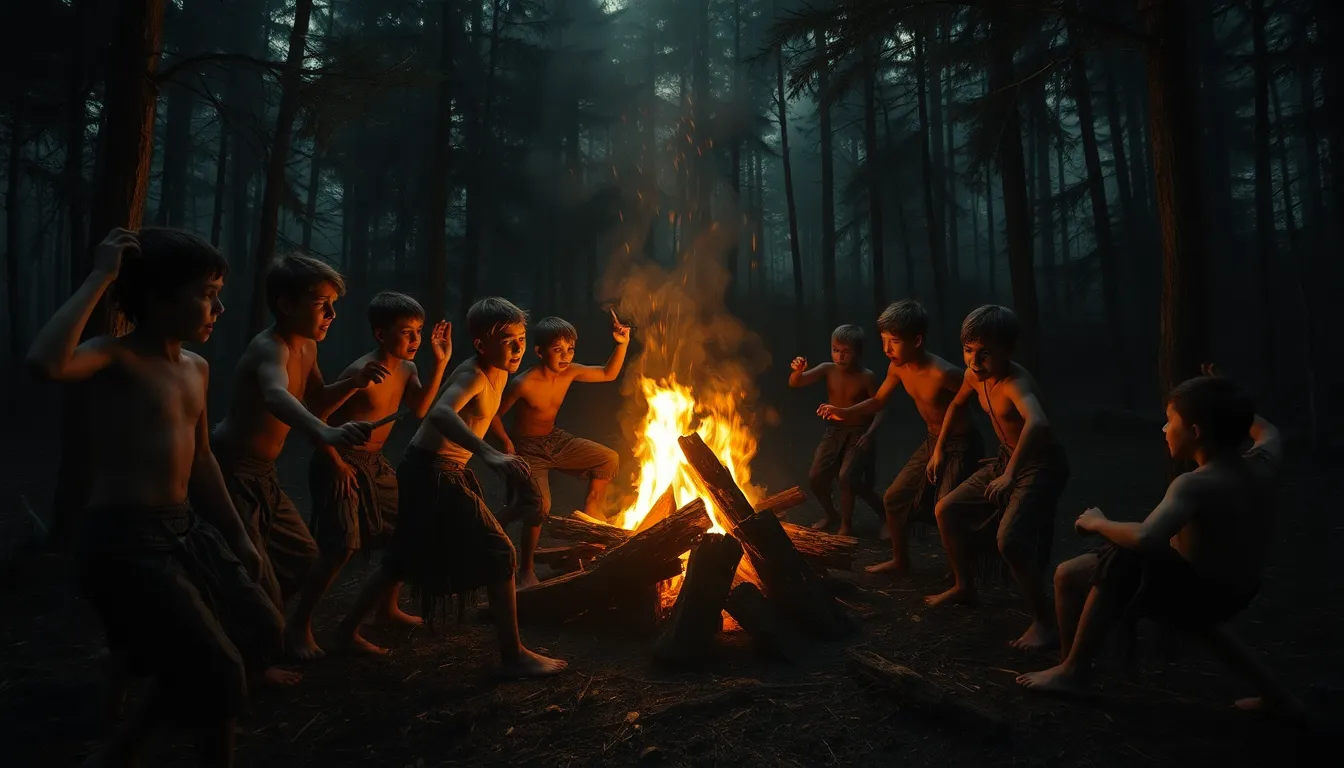In the chaotic world of Lord of the Flies, Chapter 8 delivers a wild twist that even the most seasoned readers might not see coming. As tensions rise and the boys’ civilized facade crumbles, we witness the birth of a new power dynamic that’s as thrilling as it is terrifying. Who knew a little island adventure could turn into a drama worthy of reality TV?
Table of Contents
ToggleOverview of Chapter 8
Chapter 8 of “Lord of the Flies” marks a critical turning point, escalating tensions among the boys and showcasing their descent into savagery. This chapter introduces a new hierarchy, shifting the dynamics dramatically.
Key Events in Chapter 8
A pivotal event occurs when Jack challenges Ralph’s leadership, leading to a split among the boys. Some boys choose to follow Jack and his drive for power, while others remain loyal to Ralph. This division leads to the formation of a new tribe that embraces violence as a means of survival. The boys’ encounter with the imagined “beast” reinforces their fears, propelling them toward primal instincts. Jack’s group performs a ritualistic dance, symbolizing their complete surrender to savagery. These events send shockwaves through the fragile social order established previously.
Character Developments
Jack becomes increasingly authoritarian, discarding any semblance of civilization. His desire for dominance grows stronger, transforming him into a ruthless leader. Ralph, on the other hand, struggles to maintain order and civility, feeling the weight of his waning authority. Piggy’s intellect and reasoning further contrast with the chaos surrounding him, highlighting his role as a voice of reason. Simon’s sensitivity and insight into the true nature of the ‘beast’ emphasize his isolation as the others spiral into madness. Each character evolves in this chapter, reflecting the broader themes of power and human nature amidst crisis.
Themes Explored

Chapter 8 of “Lord of the Flies” delves into significant themes that shape the narrative’s progression. Two prominent themes are the struggle for power and the loss of innocence.
The Struggle for Power
Rivalry intensifies between Ralph and Jack, illustrating the theme of power dynamics. Jack’s challenge to Ralph’s authority marks a turning point, as he rallies followers who crave strength and dominance. The formation of a new tribe showcases how individuals gravitate toward aggressive leadership. This shift signifies a rejection of order, as Jack embraces brutality over cooperation. The tug-of-war for control directly reflects human nature’s predisposition toward power. Ultimately, the decisions made by the boys reveal deep-rooted instincts that surface in the absence of societal structure.
The Loss of Innocence
Gradual transformation occurs in the boys, illustrating their descent into savagery. Innocence erodes as fear of the unknown materializes through the imagined beast. This fear compels them to adopt ritualistic behaviors, like the frenzied dance performed by Jack’s tribe. Once playful children, they evolve into creatures of violence. Simon’s isolation amplifies this theme, as his understanding of the true nature of the beast gets overshadowed by the group’s hysteria. The contrast between earlier innocence and current chaos serves as a poignant reminder of humanity’s fragility amid crisis.
Symbolism and Imagery
Symbolism and imagery in Chapter 8 of “Lord of the Flies” enrich the narrative and emphasize deeper themes.
The Beast as a Symbol
The beast epitomizes the boys’ primal fears and inherent savagery. Fear grows among the boys as their imaginations conjure a terrifying figure lurking in the jungle. Some interpret the beast as an actual creature, while others perceive it as a manifestation of their darker instincts. Encountering the beast amplifies their transformation into brutality. The boys’ reactions signal a departure from civility as they succumb to paranoia. A fear of the unknown drives them towards savage behavior, showcasing the struggle between civilization and instinct.
The Significance of the Lord of the Flies
The Lord of the Flies represents chaos and the dark side of human nature. As a severed pig’s head on a stick, it serves as a grotesque idol for Jack’s tribe, symbolizing their complete surrender to savagery. The chilling conversation between Simon and the Lord of the Flies reveals uncomfortable truths about humanity. This encounter highlights the internal battle within each character. A tangible representation of evil, the Lord of the Flies exemplifies how quickly order can dissolve into chaos. Characters become increasingly entranced by its power, reinforcing the theme of moral decay throughout the chapter.
Impact on the Story
Chapter 8 significantly alters the trajectory of “Lord of the Flies,” marking a descent into chaos and savagery among the boys.
Consequences of Actions
Jack’s challenge to Ralph’s authority directly impacts group dynamics. A split forms as boys choose sides, with violence surfacing as a tool for survival. This division prompts the emergence of a new tribe that embraces brutality. Ralph’s struggle to uphold civilization contrasts sharply with Jack’s authoritarian rule. As fear escalates, Piggy’s rational voice becomes increasingly sidelined. Characters evolve in their responses to these tensions, underscoring themes of power and corruption. Each action taken reflects the deeper consequences of abandoning societal norms, illustrating a chilling transformation from order to chaos.
Foreshadowing Future Events
The events in Chapter 8 foreshadow impending conflict and greater brutality. Tensions between Ralph and Jack’s factions grow, hinting at future violence. The boys’ encounter with the imagined beast signifies a pivotal shift toward savagery, showing their internal fears. Ritualistic behaviors emerge, indicating a deeper psychological descent. Simon’s solitary confrontation with the Lord of the Flies signals an inevitable clash of ideals. This chapter’s unfolding chaos lays the groundwork for more tragic events, reflecting the fragile nature of civilization under duress.
Chapter 8 of “Lord of the Flies” serves as a crucial juncture in the narrative where the descent into savagery accelerates. The power struggle between Ralph and Jack not only fractures the group but also highlights the inherent conflict between civilization and primal instincts. As the boys embrace violence and ritualistic behaviors, their loss of innocence becomes starkly evident.
The emergence of the Lord of the Flies symbolizes the chaos that ensues when fear and savagery take hold. This chapter foreshadows escalating tensions and impending tragedy, emphasizing the fragility of social order. The character transformations reveal deep psychological shifts, illustrating the powerful themes of power, corruption, and the darkness within human nature. As the story unfolds, the consequences of these choices become increasingly dire, setting the stage for a gripping exploration of humanity’s darker side.



